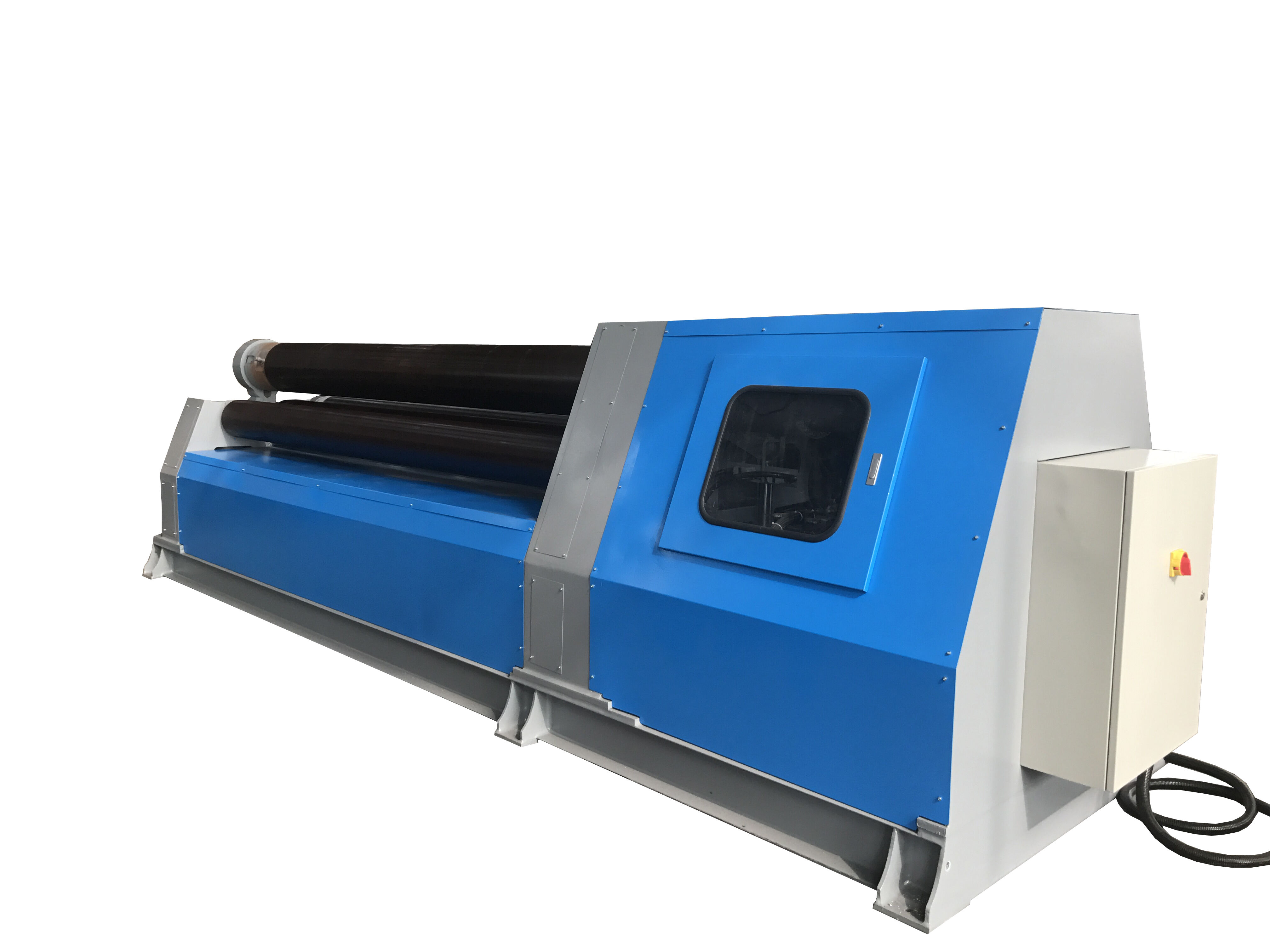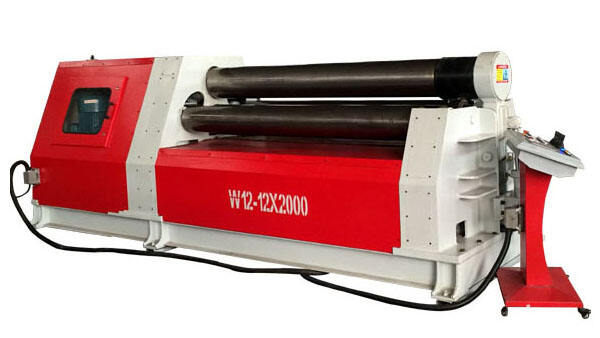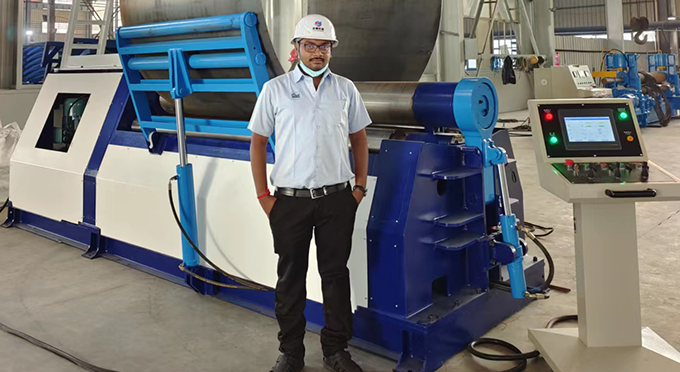Understanding CNC Controls in Plate Rolling Machines
What Are CNC Controls and How They Work in Plate Rolling
The CNC systems found in modern plate rolling machines basically take those digital blueprints and turn them into actual physical movements via programmable logic controllers. What these systems do is handle all sorts of important stuff during operation including where the rollers sit, how fast they spin around, and just how tight everything gets clamped down. Pretty cool tech actually. Some of the newer advanced models can even tweak the bend radius while working on materials based on their thickness and strength characteristics as they go along. According to recent studies from Ponemon back in 2023, this kind of smart adjustment cuts down on setup mistakes by roughly three quarters when compared to old fashioned manual techniques. Makes sense really since nobody wants wasted time or materials due to incorrect settings.
Integration of CNC with Advanced Manufacturing Systems
CNC controllers these days serve as central connection points linking plate rollers with various systems including ERP software, CAD/CAM platforms, and smart production lines equipped with IoT technology. When everything is connected properly, digital blueprints can be sent directly to machines without needing someone to manually code each instruction. According to recent industry reports from 2024, automotive parts manufacturers who adopted this kind of integrated system saw their need for fixing mistakes after forming drop by around 40 percent, and they managed to get twice as much work done in the same amount of time. These kinds of improvements are why so many shops are jumping on board with modern CNC solutions.
Simultaneous Axis Control for Consistent Shaping in Electric Plate Rolls
In CNC machining, the system coordinates several rollers so they all move together, keeping pressure even throughout the bending process. The four roller setup adjusts both vertically and horizontally at the same time, which helps prevent plates from slipping out of position. According to industry studies, these advanced machines can hit around 0.1mm accuracy on most parts, about 98% of them actually, even when dealing with tough materials like high strength steel. Some manufacturers report better results than others depending on their specific equipment configurations and operator experience.
Bridging Design and Execution: The Role of CNC Controllers
When working with CNC controllers, they basically take those 3D CAD designs and turn them into actual paths that cutting tools can follow, all while factoring in how materials tend to spring back or bend out of shape after processing. The better systems these days will actually tweak the order of bends as they go along, looking at thickness measurements in real time so everything stays within the required specs. And when dealing with cone shaped parts specifically, modern controllers crunch numbers to figure out just where to position rollers along their path. Some machines handle as many as 1200 data points every single meter of workpiece, which cuts down on wasted time from having to keep adjusting things manually through trial and error.
Real-Time Data Feedback and Closed-Loop Control for Precision
Embedded sensors in CNC plate rollers measure torque and deflection 500 times per second, creating continuous feedback loops. If a roller drifts 0.05mm beyond programmed limits, the system recalibrates axis positions within 0.2 seconds. Manufacturers report 68% fewer scrap parts after adopting these closed-loop CNC systems, along with 30% faster cycle times.
Precision and Accuracy Advancements in CNC Plate Rolling Machines
Enhanced Accuracy in Metal Forming Through CNC Automation
The precision of CNC plate rolling machines comes from their ability to program bending sequences automatically while making adjustments as they go along. These machines have closed loop control systems that check where each roller is positioned between 50 to 100 times every single second. That kind of frequent monitoring allows manufacturers to hit very tight tolerances around plus or minus 0.1 millimeters when working on important parts such as turbine housings. According to what various industry reports indicate, switching to CNC automation cuts down on those pesky geometric errors by roughly two thirds compared with traditional manual methods. The reason? Well, it gets rid of all that inevitable human error factor and keeps the pressure applied consistently throughout the whole process.
Plate Roll Crowning: Static vs. Adjustable Dynamic Systems
Modern CNC technology transforms crown compensation through dynamic adjustment capabilities:
| Feature | Static Crowning | CNC Dynamic Crowning |
|---|---|---|
| Adjustment Timing | Pre-set before operation | Continuous during rolling |
| Material Compensation | Fixed thickness profile | Real-time thickness sensor feedback |
| Typical Accuracy | ±1.2 mm | ±0.3 mm |
This advanced control method enables automatic correction for material springback, particularly effective when processing high-tensile steel alloys.
How CNC Improves Bending Consistency Across Complex Geometries
CNC plate rolling machines maintain angular consistency within ±0.5° across multi-axis bends through synchronized servo control of all rollers. The systems automatically compensate for tool deflection during conical shaping operations, ensuring uniform wall thickness in complex geometries like spiral ducting and compressor volutes.
Automation and Operational Efficiency in CNC Plate Rolling
From Manual to Smart Operation: Evolution of Control Systems
Today's CNC plate rolling machines have pretty much done away with those old manual hydraulic adjustments. Instead they use programmable interfaces that handle all the bending sequences automatically. Setup times are now about 45% faster than what we saw with traditional methods back in the day. These newer systems work hand in hand with robotic material handlers and those fancy IoT sensors, so moving from CAD designs straight to finished parts happens almost effortlessly. Shop floor operators these days just monitor everything through central dashboards rather than constantly checking calipers or adjusting levers manually like they had to do before 2015.
Increased Production Capacity and Throughput with CNC Technology
CNC plate rollers that are automated can cut down on cycle times by around 30% compared to their manual counterparts because they coordinate things like feed rates, bending angles, and where the rolls actually sit. The precision comes from those fancy servo motors that keep everything within about 0.1 degrees over hundreds of cycles, which really cuts down on wasted materials when parts don't line up properly. And here's another thing these machines do well: they have closed loop feedback systems that basically figure out how much the material wants to bounce back after being bent, then adjust on the fly. This means factories don't have to stop production every time something needs tweaking, keeping operations running smoothly day after day.
Reducing Labor Costs and Human Error Through Automation
In high volume manufacturing settings, CNC automation has cut down on plate rolling operators by around 60%. Parts are also meeting ISO 9013 standards much better than before. Tasks that used to be error prone, such as adjusting for crown compensation or dealing with asymmetric pre bending, are now handled through algorithms built into the machines' adaptive control systems. This change has slashed rework rates dramatically - going from 8.2% all the way down to just 0.9% according to Metmac's latest report from 2024. Workplace safety has improved too. The number of accidents involving pinch points and repetitive strain injuries dropped by nearly three quarters since 2018 because workers no longer need to touch the machinery directly during operation.
Workplace Safety and Ergonomic Improvements with CNC Plate Rollers
Automated Operations Enhance Operator Safety
CNC plate rolling machines today cut down on hands-on operator involvement because they come with pre-programmed bending sequences. Better quality machines have all sorts of built-in safety features these days. Think about emergency stop buttons, those safety locks that prevent accidents, and overload systems that kick in automatically whenever pressure gets too high or alignment goes off track beyond what's normal around 15%. According to a study published in Industrial Safety Journal last year, workplaces using these safety mechanisms see about a third fewer injuries than shops still relying on manual operations. Plus, production runs stay consistent throughout the day and night without needing constant supervision from workers.
Reduced Operator Fatigue and Improved Workflow Ergonomics
CNC controls cut down on all those repetitive motions by running pre-set tool paths and automatically adjusting roller positions as needed. The touchscreens these days are pretty intuitive too, which means workers don't have to mess around with those tiny micrometers anymore. Gone are the days of turning knobs 12 to 18 times for each plate adjustment. According to folks who actually work with these systems daily, there's about a third less muscle ache and joint pain overall compared to older setups, based on research from the University of Manufacturing Health last year. And let's not forget about real time monitoring through central dashboards. Techs can now keep an eye on several machines at once without having to run back and forth across the shop floor, cutting down both time wasted and potential safety risks from constant movement between stations.
Future Trends: AI, Predictive Maintenance, and Next-Gen CNC Integration
AI-Assisted CNC Systems for Real-Time Bending Adjustments
The latest CNC plate rolling machines now incorporate artificial intelligence that reads material characteristics and tweaks bending settings on the fly. Smart software takes input from pressure sensors and camera feeds to get those curves just right, which cuts down on wasted work by around 30% when making parts for planes and spacecraft. What makes these systems really stand out is how they handle springback issues automatically something that used to drive engineers crazy with traditional methods, especially when working with tough metals like titanium or advanced steel alloys.
Predictive Maintenance and IoT in CNC Plate Rolling Machines
When IoT sensors get connected to CNC controllers, it opens up all sorts of possibilities for getting ahead of maintenance issues before they happen. The data collected from things like vibration levels, temperature changes, and torque measurements in plate rollers gets fed into these fancy machine learning models. And what happens? These models can actually spot when bearings are going to fail well over 400 hours before anything goes wrong. Some big name manufacturers have seen their unplanned downtime drop by about 25% after implementing these predictive maintenance systems according to Mills Machine Works back in 2024. What this means is lower expenses on maintenance overall, plus parts last much longer too – we're talking around 18 to 22 extra months of life out of those critical components.
The Next Generation of Smart Plate Rolling Technology
The latest generation of CNC plate rollers now comes with self-calibrating features thanks to digital twin technology. These machines can actually sync their CAD designs with what's happening during actual machining processes on the shop floor. Some manufacturers who jumped on board early reported cutting down their setup time by around 15 percent when they started using cloud based simulations for toolpaths. These simulations take into consideration things like how much the machine bends under pressure and changes due to heat buildup. We're also seeing hybrid systems where CNC precision meets robotic arms for parts handling. This combination is making a big difference in operations involving thick plates over 50mm thick, where workers used to have to manually adjust everything constantly.
FAQ Section
How do CNC plate rolling machines improve accuracy?
CNC plate rolling machines improve accuracy through their ability to program bending sequences automatically and make real-time adjustments. They frequently monitor roller positions, allowing for tight tolerances.
What safety features do modern CNC plate rolling machines have?
Modern CNC machines come with pre-programmed sequences, emergency stop buttons, safety locks, and overload systems. These features enhance safety by reducing direct operator involvement.
How does CNC automation affect labor costs?
CNC automation reduces labor costs by decreasing the need for manual operation, cutting error rates, and enhancing production consistency.
What role does AI play in CNC systems?
AI optimizes bending settings in real-time by analyzing material characteristics and sensor feedback, improving precision and reducing wasted materials.
Table of Contents
-
Understanding CNC Controls in Plate Rolling Machines
- What Are CNC Controls and How They Work in Plate Rolling
- Integration of CNC with Advanced Manufacturing Systems
- Simultaneous Axis Control for Consistent Shaping in Electric Plate Rolls
- Bridging Design and Execution: The Role of CNC Controllers
- Real-Time Data Feedback and Closed-Loop Control for Precision
- Precision and Accuracy Advancements in CNC Plate Rolling Machines
- Automation and Operational Efficiency in CNC Plate Rolling
- Workplace Safety and Ergonomic Improvements with CNC Plate Rollers
- Future Trends: AI, Predictive Maintenance, and Next-Gen CNC Integration
- FAQ Section




